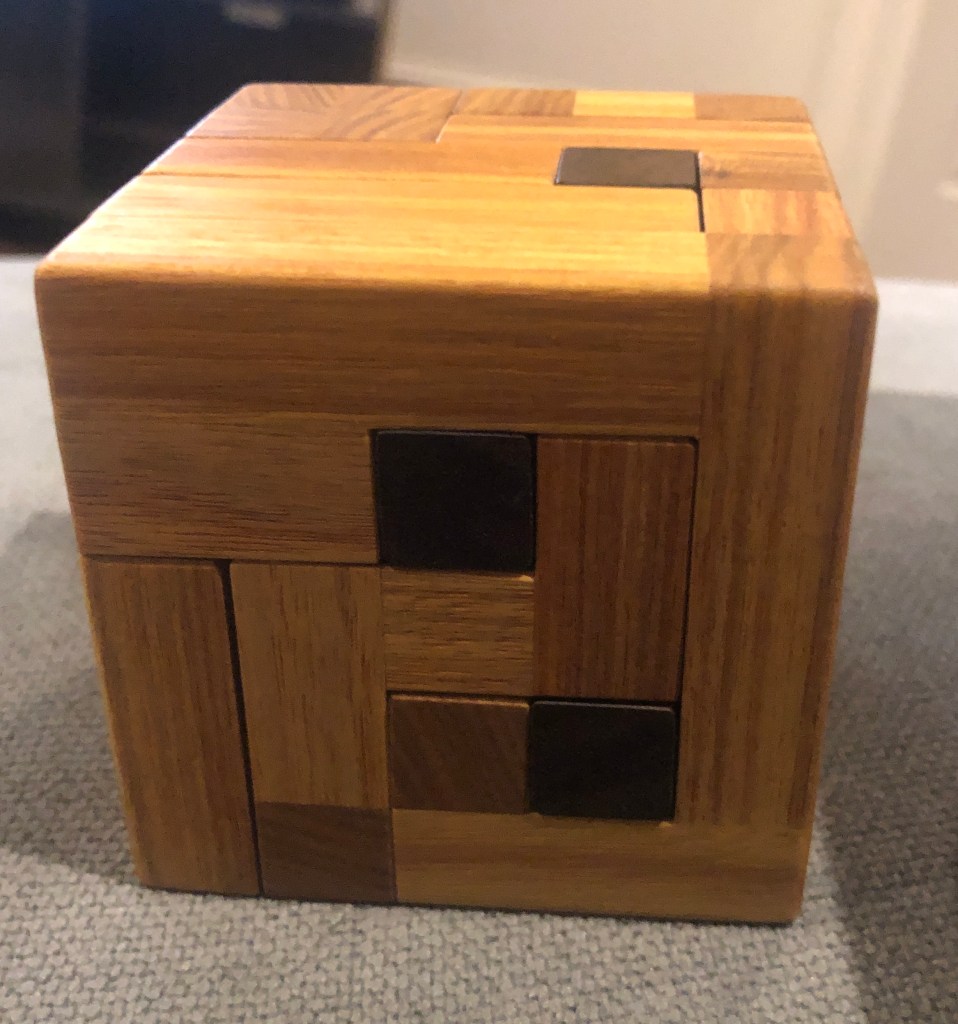Push Button Burr
Designed by Ken Irvine
Built by Tom Lensch
Let me start by saying that, historically, I am not particularly good at interlocking solids. It is only in the last few months that I have begun to expand my puzzling horizons beyond boxes, SD and locks. My first burrs had me running to fellow puzzlers that I have inter-met for burrtools files (thanks MrMark!). I at least felt vindicated by Mr. Eyckman congratulating me for having “solved” his puzzles when I returned to him, tail between my legs, for help reassembling a couple of his pieces (even worse: these were some of his simpler ones!).
I feel no shame in saying this – at least no more than general. I say it to provide some context to my imaginary readers…
Not so long ago, I ordered a few puzzles from Tom Lensch – if you do not know who he is, look him up and buy whatever he will sell you. They came quickly (and were packed amazingly well!). One of my new acquisitions was Push Button Burr, an interlocking burr cube (a puzzle-fluid identity). Designed by Ken Irvine and built by Mr. Lensch, it arrived, much to my initial dismay, unassembled!
Me of little faith, I looked at the pieces and thought that I may as well crawl into the dark hole of failure in which my meaner puzzles prowl. I had read of the joy of disassembling this puzzle – I thought that perhaps I would be able to reassemble it (with the help of some tiny colored stickers and a roll or super skinny post-it tape) after I finished taking it apart.

But when my package arrived with several more balls of bubble wrap than expected, I realized that my assumption did not match that of the master Mr. Lensch who puts interlocking burr cubes together for breakfast.
Instead of a solid cube with little brown buttons, I had a few twisted crazy pieces of varying strange Seussian shapes, and five identical brown sort-of Z’s. What to do? Do I first work on some of the other puzzles that had arrived? No! Do I immediately give up and ask for the solution? Maybe! Do I stare at it stupidly for longer than I care to admit? Probably!
But if I were to assemble it based on instructions, I would kill the fun of disassembly (this works better the other way). So you know what I did? I did another puzzle.
Later, after getting myself in the right mindspace by failing to solve something else, I sat down with my dysmorphic cube pieces and figure I will at least try before probably failing.
And try I did – it took me a while, but I was able to build the frame; it made more sense to me than many such spatially demanding puzzles do – perhaps the disorder saw something in me and decided to give me a break. Eventually, however, build it I did! I was pretty satisfied with myself, until I remembered the five buttons still sitting there outside my almost-cube. The nature of this puzzle is such that it looked close to finished – absent a few holes (10 if you have not guessed), the cube was complete.
Now here is one of the things that makes this such a great puzzle: building it had required trial and error, memory, and, yes, a bit of thought. But getting these buttons in? Well, that is going to take a lot of thought! Not my strong suit, but let’s see if any of those brain cells survived my adolescence.
And so I thought before trialing. And then I thought some more after erroring. Slowly, a dance began to form. These would require a very specific order, back and forth, cube and button, button and cube; the cage was there but must be rebuilt with its prisoners present. And, eventually, I saw it: the right order, in the right way, and piece after piece slid into place, leaving my buttons ready to be pushed (unpushed?).
Declaring myself the smartest man in the world (or at least the room), I gleefully showed by wife, who, true to herself, didn’t really care but did afford me a brief “That’s nice, dear, now shut up” look. But I was too busy admiring my utter and complete brilliance: clearly it goes Albert Einstein, David Byrne, me, and then whoever invented the pop tart.
After doing my happy dance for an acceptable amount of time, I proceeded to do it for an uncomfortably longer time. I went to discord and bragged about something so many others can do more easily than I. And then I went back to push buttons and let the dance play out in reverse, appreciating the creativity it took to design this mashup and the skill that went into making it.
High on my own utter and complete genius, I went back to Stumbling Blocks and was quickly and absolutely humbled.
Oh well, it was good while it lasted.

You utterly ruled that one, and it is NOT an easy assembly. What a great state of mind you most have been in to focus and see and find your way to solving it. Congratulations!
LikeLike
Thanks man! Such a great thing when you can really grok a puzzle.
LikeLike